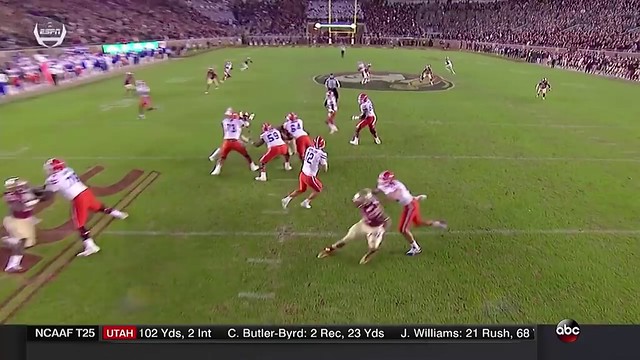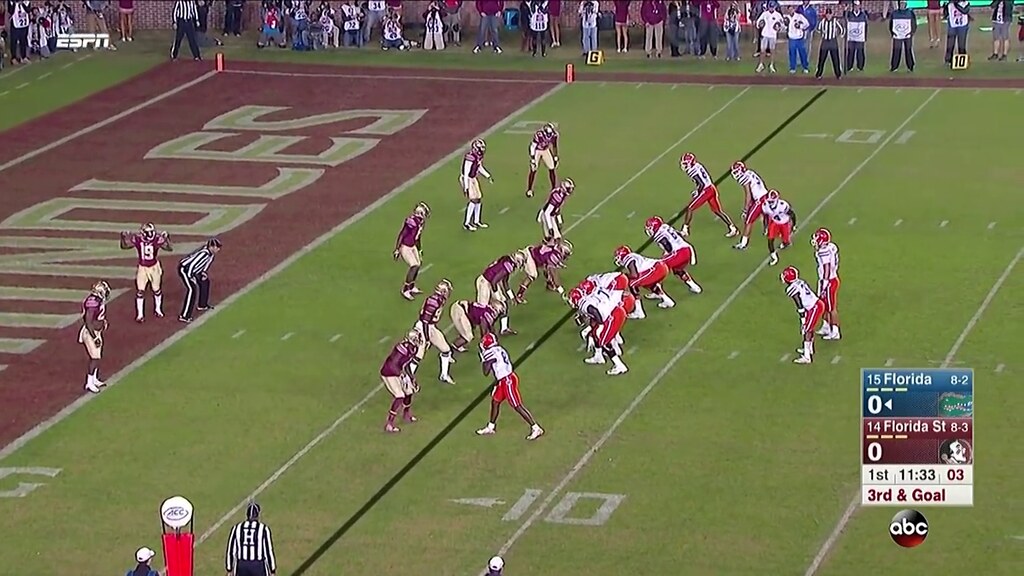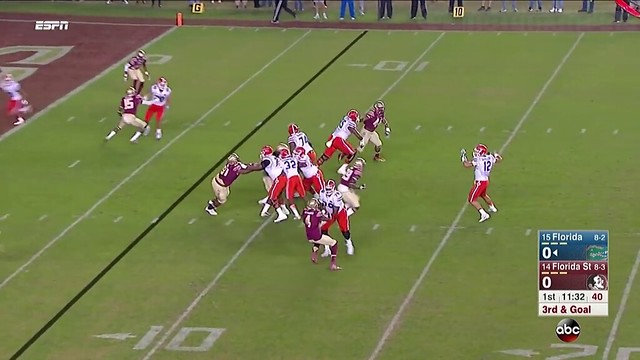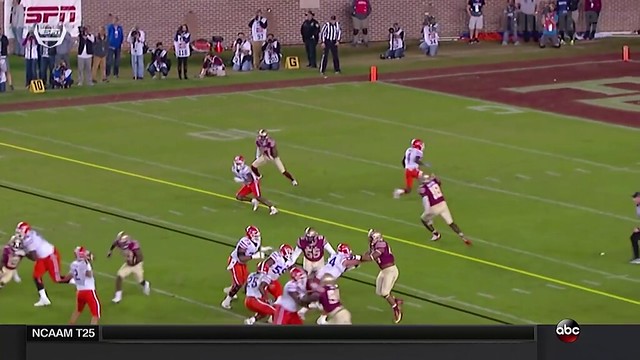Fee Fi Foe Film: Florida State Defense

Previously: Florida State Offense
...damn.
As it turns out, not having a functional passing game against Florida State's defense is a serious issue. Florida, a subpar-at-best running team, managed a respectable 4.6 yards on 23 non-sack rushes against FSU. On their 41 dropbacks, however, they gained only 149 yards through the air and lost 46 on six sacks for a total average of 2.5 yards per pass play.
Michigan, with a month to prepare a superior offense, will fare better than Florida. They'll still deal with the same core issue: how do you slow down FSU's pass rush enough to consistently move the ball?
Personnel: Seth's diagram [click to embiggen]:
FSU is dealing with serious injury problems in their secondary. Star free safety Derwin James was lost early in the season; starting strong safety Nate Andrews tore his pectoral against Miami; replacement Ermon Lane, who made a midseason move from wide receiver, is out after suffering a foot injury in practice. What had been arguably FSU's strongest position group is now piecing a lineup together with scotch tape and chewing gum:
With Lane out FSU will likely move Trey Marshall back from the star position, and move true freshman Kyle Meyers into his spot. Meyers has played quite a bit this season with Marshall moving back and forth between the safety and star positions, as well as an injury that kept him out of the NC State game.
If FSU wants to keep the physical Marshall close to the line of scrimmage to help out against the Wolverines downhill rushing attack, then it will be sophomore defensive back Calvin Brewton that will play opposite of sophomore A.J. Westbrook. Brewton has played sparingly this season, but he has played more than true freshman Carlos Becker.
Florida wasn't able to test FSU's safeties at all in the passing game; that shouldn't be the case with Michigan.
Base Set? 4-3, often with a standup weakside DE; FSU uses the same "BUCK" term for that position that DJ Durkin used in his time at Michigan.
[Hit THE JUMP for the rest of the breakdown.]
Man or zone coverage? A lot of zone, especially Cover 2. FSU saves man coverage mostly for their more elaborate blitzes. The Noles have a lot of big, rangy defensive backs—everyone in their starting secondary is at least 6'0"—who are good at coming downhill against the run and closing on passes, and the zone-heavy scheme plays to their strengths. Austin Appleby isn't a very good starting quarterback; he also didn't have a lot to work with in this game:

On this particular play, he rolled right to escape pressure and the corner playing the flat closed in to force a throwaway.
Pressure: GERG or Greg? One thing FSU did very well in this game was disguise their blitzes, which was especially effective since Florida had to focus a great deal of attention on DE DeMarcus Walker (more on him soon). The Noles consistently got pressure with a four-man rush, but on third downs they liked to bring heavier pressure and force Appleby into hasty decisions. Their ability to disguise blitzes and overload one side without devoting too many players to the rush made this work. Just based on the number of players in the box, Florida has enough blockers here to handle any blitz FSU brings their way:

FSU overloads the near side, however, and Florida made multiple errors: the line didn't slide their protection and the running back picked the wrong guy. Appleby rushed a throw that got stopped short of the goal line because, despite it being 5-on-5, FSU got a free rusher:

Here's another example from the very next play. Safety/HSP Trey Marshall lines up as if he's going to drop into coverage; only a subtle peek into the backfield tips that he may blitz. Neither Appleby nor the running back notices this and once again FSU gets a rusher in free in a 5-on-5 situation—Appleby is immediately under duress with nobody open:
The variety and unpredictability of FSU's blitzes can cover for some issues with their injury-plagued secondary. The slot receiver (#4) is about to be wide open on a corner route for a touchdown here but Appleby is already throwing the quick hitch—which Marquez White (#27) will break up—because there's another free hitter in his face:

FSU doesn't play flawless coverage—far from it, in fact—but they force the quarterback, offensive line, and running back to make a lot of quick decisions that often lead to mistakes. Florida's passing offense up and died because Appleby isn't great and his blockers consistently blew protections. Michigan should do better in both the passing and blocking aspects; it'll still be a challenge to keep Wilton Speight from being harrassed into a couple errors.
Dangerman: FSU's two best linemen are up there with the two best linemen from any program in the country. 280-pound SDE DeMarcus Walker is an absolute terror against both the run and the pass. He leads the team with 63 tackles, 41 of which are of the solo variety; if he's singled up on a blocker, especially a tight end, he's going to win far more often than not, and he does a great job of shedding and tackling against the run. He's even better against the pass in large part because he explodes off the snap:
Walker can rush off the edge or, as in the clip at the top of the post, from the interior, and he's equally effective from either spot. Michigan has faced a number of great defensive linemen this year; Walker's performance against Florida is the best I've seen from any of them. He'll give Michigan's tackles all they can handle and then some.
It doesn't get much easier on the interior due to the presence of 312-pound nose tackle Derrick Nnadi, who shouldn't be blocked one-on-one:
Much like Ryan Glasgow, Nnadi makes some sideline-to-sideline plays that most NTs simply aren't capable of making:
Mason Cole has had a tough time with some of the more elite NTs on Michigan's schedule, and Nnadi certainly qualifies as such. He's not unmovable—Florida got some decent push on him with double-teams a few times—but he demands double-blocking, and that can be tough with Walker on the same line.
In the secondary, sophomore Tarvarus McFadden is the top playmaker; he has eight picks, five PBUs, and three TFLs from his corner spot. He's not a lockdown corner. Florida beat him for a pitch-and-catch first down on a slant and had a couple chances to hit deeper throws that Appleby missed. He's still decent in coverage, though, and he can swing a game with big plays. He dropped a pick after jamming the hell out of another slant and running the route for the receiver; he forced Florida into a fourth-and-one with one of the more improbable tackles I've seen:
McFadden is well back of Walker and Nnadi in terms of down-to-down impact, but he can have a similar overall effect on the game in only a handful of plays.
OVERVIEW
Florida's relative success running the ball gives me hope that despite the presence of Walker and Nnadi, Michigan will be able to consistently move the chains. DT Demarcus Christmas is a solid plugger up front who complements Walker and Nnadi well. The key for Florida was getting to FSU's backup DTs, who were a clear step down, if they wanted to move the ball between the tackles. Whether against the starters or backups, however, Florida had most of their success on the edge:
That particular play is an example of why freshman Brian Burns (#99), who has 8.5 sacks this year, almost exclusively plays on passing downs. Starter Josh Sweat is the opposite type of player, stout against the run and a relative non-factor as a pass-rusher.
The linebacker group didn't impress me very much. Ro'Derrick Hoskins is a good run-stuffer between the tackles but looks ponderous when he has to get to the edge. Surprisingly, that was also the case with Jacob Pugh, their nominal spacebacker—he's #16, the playside linebacker on this end-around:
The WILL, Matthew Thomas, did well in pass coverage on the occasion he was targeted downfield, sticking with a wheel route all the way. Against the run, however, he looked hesistant on a few plays, waiting and catching blocks instead of attacking his gap.
The secondary is big, rangy, and capable of making a lot of plays because they're almost always facing the backfield—an advantage of the zone-heavy system. Florida's lack of a downfield passing game kept the safeties from being involved much at all. There did appear to be a blown coverage or two—someone missed their assignment on the hitch/corner combo screencapped in the blitz section but there wasn't a useful replay—but the pass rush covered for most apparent issues. The PFF grades indicate you can move the ball through the air on these guys, especially when picking on the non-McFadden DBs. Trey Marshall and Marcus Lewis are both in the red in pass coverage and staring corner Marquez White is only a couple points to the positive.
While Walker and Nnadi are going to get theirs, Michigan should be able to put together a game plan that produces enough points to win this game. I'd bet Harbaugh focuses a good deal on taking advantage of the linebacker level; Florida doesn't have a tight end close to the caliber of Jake Butt, let alone a deep group of contributors at that spot. Quick-hitting plays to the edge—like, say, Eddie McDoom jet sweeps and their various counters—could also hit for long gains. Florida missed some openings to hit big plays deep; Michigan has both a better quarterback and better receivers, plus a running back who's very good at picking up blitzes.
This one could come down to which team comes out with a positive RPS number, especially when FSU blitzes. With a month to prepare, I like Harbaugh's chances of coming out on top.
December 29th, 2016 at 12:18 PM ^
I've watched FSU against non-incompetent offenses this year and thought that a lot of their aggression could be used against them. Ole Miss, which has basically no running game and had to replace a lot of offensive talent, moved the ball reasonably well against them. Same with UNC, Clemson, Louisville, and even USF. Given, those are different offenses than they'll see against UM, but this is a unit that can absolutely match or exceed those offenses in terms of overall talent and diversity of playcalling, and I doubt FSU will bottle them up.
December 29th, 2016 at 3:28 PM ^
has Orange Bowl as a pickem?
December 29th, 2016 at 4:00 PM ^

Comments